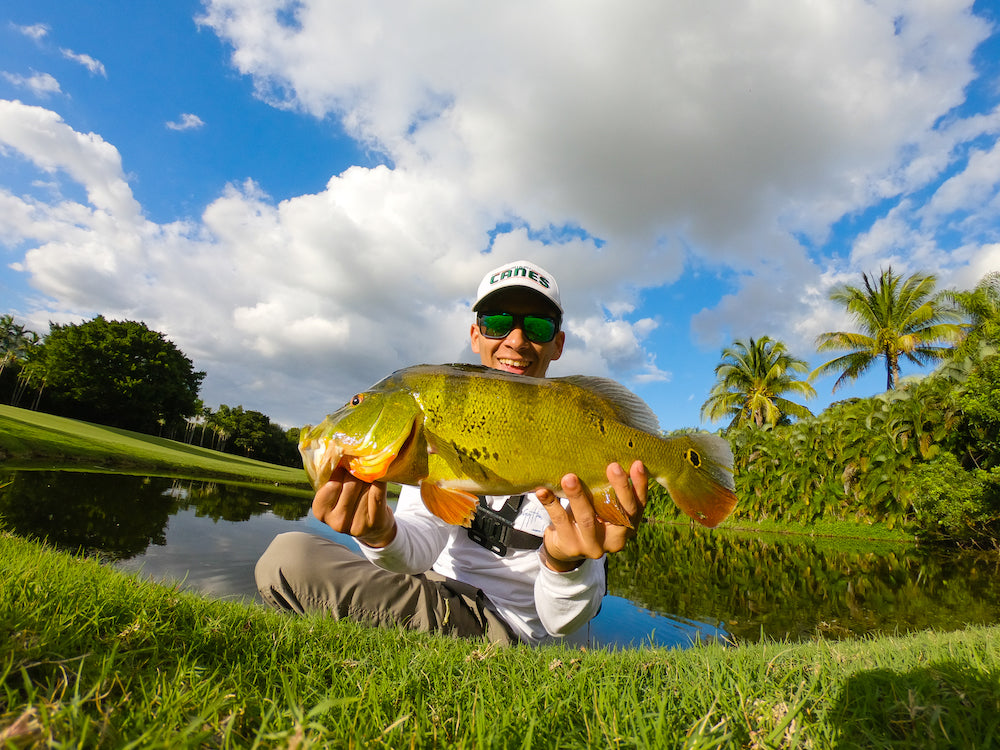Fishing For Peacock Bass In Florida (The Ultimate Guide)
The Peacock Bass (or Butterfly Peacock) was introduced to Florida waterways between 1984 and 1987. During those three years, the FWC stocked nearly 20,000 butterfly peacock fingerlings into the canal systems of South East Florida. Although exotic to Florida, they help combat and increase predation of other exotic species, mainly the African Spotted Tilapia.
FWC performed years of research before deciding to introduce this species. Besides the positive effects on the eco-systems, they provide excellent sport fishing opportunities. There are 15 different peacock bass species, but the butterfly peacock is the most prevalent in Florida.
FWC attempted to stock the speckled peacock bass, but they have not flourished like the butterfly peacock. To get scientific, the peacock bass is not a member of the bass family but part of the 1,600 plus tropical members of the cichlid family.
Peacock Bass Appearance
The peacock bass is similar in shape to the largemouth bass. Along its body, you will find iridescent hues of green, blue, and orange. You can also notice it has three distinct vertical black stripes. On its caudal fin, there is a black spot surrounded by a silver halo. There will often be many variations in colors and patterns from fish to fish.
During the breeding season, the mature males will grow a large lump on their head. The reason for this is unknown, but there has been much speculation. A fun trick when you catch one: gently rub the hump on their heads, it’ll make their spines stand up!
Peacock Bass Habitat

Any water colder than 60 degrees might kill the peacock bass. For that reason, you are unlikely to find them in any northern parts of Florida. The Florida canal systems rarely drop below 65 degrees because of the Biscayne Aquifer right below the surface. This has been the main reason many exotic species have survived colder than normal winters and the Peacock Bass is no exception.
However, they’re restricted to freshwater and cannot migrate into the brackish areas like some fish. They can accidentally get swept into salty water because of Florida’s spillways. Just like the popular largemouth bass, butterfly peacocks are typical ambush-predators and like to hang around structure and vegetation.
Peacock Bass Fishing Tips & Tricks
Recommended Guide: Capt. Patrick Smith (561) 503-0848.
Anglers who are targeting peacock bass can feel safe using light spinning tackle. It will help induce more strikes and will make the fight way more fun! Don’t worry, these are open water fighters and they won't typically wrap you around structure and cut your line. You want to target peacock bass during the daylight hours. You will find this beneficial if you're not a morning person: sleep in!
When targeting bedding fish always remember to only catch one fish and to try your best to return the fish to the bed. We do not want to disturb the reproductive process of peacock bass. Catching both fish will leave any eggs or young peacock bass vulnerable to prey. Also, we want to ensure that they produce as many babies as possible and they get bigger for us to all have more and bigger fish to catch.
Best Peacock Bass Bait / Lures

The best-producing baits by far are small shiners around 2-3 inches. For a few bucks a dozen they are worth their price tenfold. Peacock bass will not let more than a few seconds pass before destroying a fresh shiner. Just remember, do nothing besides drop it in the water as close as you can to a peacock and let it do its thing.
Artificial lures will work as well and are more rewarding. Using something that resembles a frantic minnow fleeing or injured should produce. A Rapala husky jerk or Xrap are my go-to jerk baits to induce a reaction bite. Any topwater lure will provide great excitement and is my favorite way to fish for peacock bass.
You can use many of the same lures as you do for largemouth bass. The only distinction is that peacocks will not eat artificial worms (a popular largemouth bait).
For the fly enthusiast, poppers and small streamers should provoke a bite. Be ready, these fish are exceptional fighters. If the fish are bedding, use a fly with a quick sink rate and plop it right onto the bed. A peacock's first instinct is to attack so it can protect the bed. My go-to fly is a clouser with medium eyes, always seems to do the trick.
Check out our favorite peacock bass lures.
Finding Peacocks
If you are looking for specific locations, we suggest you look at FWC’s southeast canal guide. They have useful maps and locations available for both boaters and non-boaters. If you are looking for a public lake, may we suggest the Lake Ida chain. The hidden gems are the private lakes contained within neighborhood gates. Start asking your friends and family if you can fish within their gated community.
From experience, when fishing other lakes, make sure you are not trespassing. This could cause some angry neighbors yelling at you, or worse, police being called. Always park your car in safe places not susceptible to towing or tickets (also from experience). There are spots just as good as the dangerous or risky ones, you might just have to walk/drive a little further but it’s worth the peace of mind.

